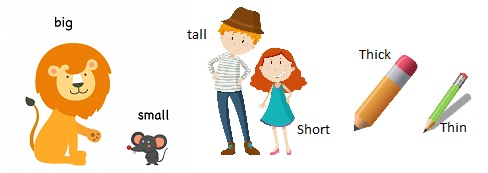As we know about the Numbers e.g. 1, 2, 3, 4…. And so on. With the help of numbers we can easily counting the things is easy for us now.
While use of numbers we can know many things about them. Numbers help us Count concrete objects. It can be used in many different contexts and in many ways.
We enjoyed working with numbers in our previous classes. We have added, Subtracted, multiplied and divided them Now we Learn here some more.
As we have done many things for compare e.g. Big-small, Tall-Short, Thick-thin etc.

So here we go to learn about the Comparisons with Numbers. It's easy, let us see if we remember which is the greatest and lowest among these :
Stand/Arrange in proper order-
Ascending order-: Ascending order means arrangement from the smallest to the greatest or thinner to thicker or shorter to taller etc.

In same way we can arrange the numbers in Ascending order or say Increasing order -:
32, 45, 89, 100, 125, 5000 etc.
Descending order Descending order means arrangement from the greatest to the smallest or thicker to thinner or taller to shorter etc.

In same way we can arrange the numbers in Descending order or say Decreasing order -:
5000, 125, 100, 89, 45, 32 etc.
Expansion
Expansion of the numbers mean extend the numbers with the place values e.g. 10(ten)s, 100(hundred)s, 1000(thousand)s and so on.
H T O Expansion
2572 x 100 + 5 x 10 + 7 x 1
H |
T |
O |
Expansion |
|
|---|---|---|---|---|
|
2 |
5 |
7 |
= |
2 x 100 + 5 x 10 + 7 x 1 |
Similarly, for 2902,
Th |
H |
T |
O |
Expansion |
|
|---|---|---|---|---|---|
|
2 |
9 |
0 |
2 |
= |
2 x 1000 + 9 x 100 + 0 x 10 + 2 x 1 |
29022 x 1000 + 9 x 100 + 0 x 10 + 2 x 1
In our Indian System of Numeration we use ones, tens, hundreds, thousands and then lakhs and crores. Commas are used to mark thousands, lakhs and crores.
For example-:
5, 08, 01, 592
3, 32, 40, 781
In the International System of Numeration, as it is being used we have ones, tens, hundreds, thousands and then millions. One million is a thousand thousands. Commas are used to mark thousands and millions. It comes after every three digits from the right.
In earlier classes, you learnt how use centimeter (cm) as a unit of length.
Basically there are various units available in the world to measure and each things has special unit for measurement.
For Distance measuring we can use — Meter, kilometer
1 kilometer = 1000 meters
1 meter = 100 centimeters
1 kilogram = 1000 grams
1 gram = 1000 milligrams
To know more make the section or popup for units conversion
Estimation- Estimation means approximate also say in rounding off. The word approximately itself shows that the number of people were near about these numbers.
e.g. Clearly, 51,000 could be 50,800 or 51,300 but not 70,000.
| Given Number | Approximate to Nearest | Rounded Form |
|---|---|---|
|
75847 |
Tens |
1.3.6 To estimate sum or difference
Round off to thousands.
17,986 rounds off to 18,000
+5,290 rounds off to + 5,000
Estimated sum = 23,000
1.3.7 To estimate products
How do we estimate a product?
What is the estimate for 19 x 78?
It is obvious that the product is less than 2000. Why?
If we approximate 19 to the nearest tens, we get 20 and then approximate 78
to nearest tens, we get 80 and 20 x 80 = 1600
Brackets are saying us that shows commonly match each other. turn everything inside the brackets ( ) into a single number and then do the operation outside.
Expanding brackets
7 x 109 = 7 x (100 + 9) = 7 x 100 + 7 x 9 = 700 + 63 = 763
On of the another Numbers system known as Roman Numerals. One of the early systems of writing numerals is the system of Roman numerals. This system is still used in many places.
The Roman numerals :
I, II, III, IV, V, VI, VII, VIII, IX, X etc.
